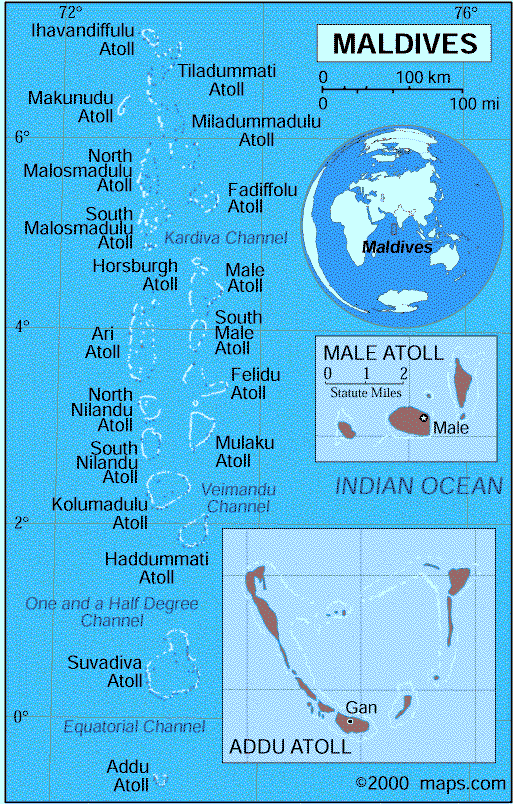MALDIVES

Geography: The Republic of Maldives is a group of atolls in the Indian Ocean about 417 mi (671 km) southwest of Sri Lanka. Its 1,190 coral islets stretch over an area of 35,200 sq mi (90,000 sq km). With global warming and the shrinking of the polar ice caps, the Maldives is directly threatened, as none of its islands rises more than six feet above sea level.
Government: Republic.
History: The Maldives (formerly called the Maldive Islands) were first settled in the 5th century B.C. by Buddhist seafarers from India and Sri Lanka. According to tradition, Islam was adopted in 1153. Originally, the islands were under the suzerainty of Ceylon (now Sri Lanka). They came under British protection in 1887 and were a dependency of then-colony Ceylon until 1948. An independence agreement with Britain was signed July 26, 1965. For centuries a sultanate, the islands adopted a republican form of government in 1952, but the sultanate was restored in 1954. In 1968, however, as the result of a referendum, a republic was again established in the recently independent country. Ibrahim Nasir, the authoritarian president since 1968, was removed from office and replaced by the more progressive Maumoon Abdul Gayoom in 1978. Gayoom was elected to a sixth five-year term in 2003.

Map of Maldives
President: Abdulla Yameen (2013)
Total area: 116 sq mi (300 sq km)
Population (2014 est.): 393,595 (growth
rate: –0.09%); birth rate: 15.59/1000; infant mortality rate: 24.59/1000;
life expectancy: 75.15
Capital and largest city (2011 est.):
Malé, 132,000
Monetary unit: Rufiya
National
name: Dhivehi Raajjeyge Jumhooriyyaa
Languages:
Maldivian Dhivehi (official); English spoken by
most government officials
Ethnicity/race:
South Indians, Sinhalese, Arabs
Religion:
Islam (Sunni)
National Holiday:
Independence Day, July 26
Literacy rate: 98.4% (2006 est.)
Economic summary: GDP/PPP (2013 est.):
$3.073 billion; per capita $9,100. Real growth rate: 3.5%.
Inflation: 5.1%. Unemployment: 28% (2012 est.).
Arable land: 10%. Agriculture: coconuts, corn, sweet
potatoes; fish. Labor force: 159,700 (2012); agriculture 15%,
industry 15%, services 70% (2010). Industries: tourism, fish processing, shipping, boat building, coconut processing, garments, woven
mats, rope, handicrafts, coral and sand mining. Natural
resource: fish. Exports: $283 million (2012 est.). Imports: $1.406 billion (2012 est.) Major trading partners:
Thailand, Sri Lanka, France, UK, US, Singapore, UAE, India,
Malaysia, China, Germany, Italy (2012).
Communications:
Telephones: main lines in use: 23,140 (2012); mobile cellular:
560,000 (2012). Broadcast media: state-owned
radio and TV monopoly until recently; state-owned TV operates 2
channels; 3 privately owned TV stations; state owns Voice of Maldives
and operates both an entertainment and a music-based station; 5
privately owned radio stations (2012). Internet
Service Providers (ISPs): 3,296 (2012). Internet users: 86,400
(2009).
Transportation: Railways: 0 km.
Highways: total: 88 km. Ports and
harbors: Malé. Airports: 9 (2013).
International disputes: none.
-------------------- o --------------------
No comments:
Post a Comment